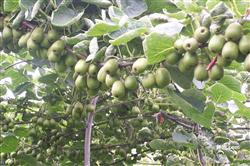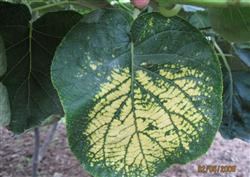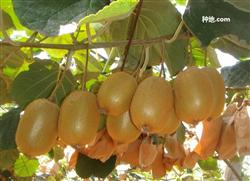How can kiwifruit be planted with high yield?

How can kiwifruit be planted with high yield? Please refer to the following planting techniques for high yield of kiwi fruit: First, the selection of varieties should choose fruit shape, good quality, strong disease resistance, high yield of good varieties, such as Hayward, Allison, Bruno and so on. Second, the selection of garden kiwifruit likes cool and humid environment, afraid of drought, afraid of waterlogging, afraid of wind, cold, but not resistant to early spring late frost, so mountain kiwifruit garden should be selected in the leeward sunny hillside or open space, soil to loose, good drainage, high organic matter content, pH value in 5.5-6.5 slightly acidic sandy loam is good. 3. Cultivation method: Dig planting holes before planting. The diameter of the holes is 1 meter and the depth is 40-50 cm. Apply compost 40-60 kg, phosphate fertilizer 20 g and calcium magnesium phosphate fertilizer 400 g to each hole. The planting time can be from autumn defoliation to early spring germination, but it is better to plant in late October in autumn and late February in spring before shoot bleeding. The plant spacing was 4.6×6.0 m. In order to increase early yield, dense planting with double quantity, thinning after mature plants, and mixed planting with 20% pollinated male plants can be used. 4. Scaffolding is generally used for cultivation. There are shed frames, arch bridge tunnel frames and fence frames. Horizontal scaffolding is the most suitable. 5. Summer management After summer germination, the lateral vines should be removed. From June onwards, new shoots should be tied regularly to make them evenly covered with the frame surface. 10-15 nodes were reserved for the fruiting branches, 15-20 nodes for the vegetative branches, and the rest were all removed. 6. Artificial pollination and fruit thinning First, the pollen of male flowers is diluted to 10 times with lycopodium album, and then pollinated with cotton sticks. In addition, male flowers can be connected to the female branch high, or let insects pollinate. Thinning flowers and fruits should be early, and its standard is: leaving 1 fruit per node on the fruiting branch, thinning the lateral fruit and leaving the middle fruit. It can also be used as a standard for leaf-fruit ratio, that is, one fruit for every 4-5 leaves. Generally, 1-2 fruits are reserved for weak fruit branches 20 cm long, 3-4 fruits for fruit branches 20-60 cm long, 5-6 fruits for fruit branches more than 60 cm, and 20,000 fruits for every 1.5 mu area. 7. Winter pruning is carried out from late December to late February of the following year. After winter shearing, 3-4 fruit branches and 15-16 buds are generally left per mu. The structure of each tree is 1 trunk, 2 main branches, 3 auxiliary main branches, 26 lateral branches, 90 fruiting mother branches and 315 fruiting branches. The harvest of kiwi fruit is carried out from mid-September to mid-October. The fruit is ripe enough to be picked. Picking should be picked gently, stacking should avoid extrusion, bruising. After harvest, it can only be eaten after 8-10 days of ripening. Nine, pest control said monkey peach disease resistance, insect resistance is very strong, its main pests are small leafhopper, bean moth and scale insect, etc., should take corresponding measures, do a good job of prevention and control. Click for more kiwi growing techniques Click for more fruit growing techniques
- Prev

What will happen to kiwifruit due to nitrogen deficiency?
How to prevent and cure yellowing of kiwifruit? Please guide kiwifruit chlorosis is actually iron deficiency chlorosis. Iron is necessary to maintain the function of chlorophyll. The initial symptom of iron deficiency is yellowing or chlorosis of young leaves, but it is not certain that iron deficiency continues to develop, which in turn makes the leaves white and white.
- Next

How to fertilize kiwifruit scientifically
How to fertilize kiwifruit scientifically? Please guide kiwifruit to adapt to warm and humid slightly acidic soil, most afraid of heavy viscosity, strong acid or alkaline, poor drainage, excessive drought, barren soil. Therefore, measures of improving soil fertility can be taken to improve soil physical and chemical properties and create the optimal ecological environment for its growth. Nitrogen.
Related
- Moge, come on! The staff of the peasant association in the producing area of cantaloupe were frightened when the crowd gathered.
- Causes and Solutions of low Fruit setting rate of Apple
- Symptoms and control measures of passion fruit virus disease
- Fruit growing lesson: how do apple orchards keep high yields?
- Can you build orchards in the mountains? What are the pros and cons?
- How to manage the coloring period of Crisson grape?
- This paper introduces the processing technology of two kinds of fig products.
- How much is a month for retired teachers in rural areas by 2020?
- How can strawberry planting increase sugar content? We should pay attention to management in many aspects.
- What are the cultivation techniques on how to improve the yield of golden fruit?

